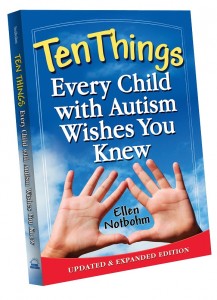Ten Things Every Child with Autism Wishes You Knew
 This week we welcome Ellen Notbohm to the blog! Ellen is the author of the book, Ten Things Every Child with Autism Wishes You Knew. We chose a question asked by our Facebook community for Ellen to answer in her special guest post. Ellen’s advice is always helpful for parents of children with autism as well parents of typically developing children.
This week we welcome Ellen Notbohm to the blog! Ellen is the author of the book, Ten Things Every Child with Autism Wishes You Knew. We chose a question asked by our Facebook community for Ellen to answer in her special guest post. Ellen’s advice is always helpful for parents of children with autism as well parents of typically developing children.
Q: I teach children who have autism, so I often wish I could get inside their heads to know what’s motivating them. Each is so individual in their likes and dislikes. The aggression towards staff and students of one boy I taught was so hard to manage, I feel like I failed him, his family and his classmates by not being able to establish a safe place for him to learn. What do you think he would have told me if he could have?
A: All humans–all creatures–need a functional means of communication. In our culture, we’ve designated speech as the gold standard of interpersonal communication. Parents of nonverbal or minimally verbal children are often consumed with the urgency of teaching their child to talk. This emphasis on “using our words” is so prevalent that when children with under-developed language skills reach out to us nonverbally, we may miss their attempts to connect. Nearly all children with autism need some form of adaptive communication. When we fail to give a child a functional, meaningful means of communication, his needs and wants go unmet and he finds a way to communicate by whatever means he can. This is what your student was telling everyone around him, loud and clear–that he was not able to express his needs and wants in the manner expected by the adults around him and had not been taught an alternate form of functional communication. He was forced to resort to the only other means he had–his behavior.
Our insistence that our children “use their words” should be only the starting point for our recognizing their efforts to communicate, because words are only a small part of all comprises interpersonal communication. We communicate through the nuance of language (sarcasm, innuendo), through the inflection, pitch and speed of our speech. We communicate through body language, facial expressions, emotional responses, postures and gestures. We communicate through proxemics, allowing some people to come near to us while keeping our distance from others, engaging in or avoiding physical contact and/or eye contact.
Most typically-developing children communicate easily using eye contact, body posture, pointing, but most kids with autism have difficulty indicating interest. They often lack the social thinking skills to know what to reference. Their motor systems can’t plan, coordinate and execute in a way that produces a spontaneous gaze or gesture. We must look farther than the child’s movements or words to be able to hear his needs, thoughts, feelings and longing to communicate.
All behavior is communication, and all behavior has a source. As adults, we often fail to seek out that root cause, perhaps assuming that the child could change this behavior if he wanted to, perhaps trying to squash the behavior without identifying the underlying reason for it. Quelling troubling behavior begins with understanding that the child is giving us information about sensory, language, social and emotional factors in his environment that are affecting his ability to cope. He is telling you that his so-called negative behavior is preventable, but only if you are willing to root out and address the cause. And we must acknowledge that our own behavior is information we impart to the child about his environment. We can’t question what his behavior is telling us without also questioning what our behavior is telling him.
Our job to break down this complex landscape of interaction into parts manageable enough to give the child with autism a meaningful and functional communication system, in whatever form it may take. When I speak at conferences, I put my audience through an exercise simulating what it might be like to lose their functional means of communication. We envision beginning our day by having our mouths taped shut and our fingers taped together. No phone, no email, no texting, no Facebook or Twitter. No functional communication as they know it. Then I ask them to imagine going about their day, their jobs, their responsibilities, confronting the expectations of those around them. They must ask themselves:
How effective would I be?
How successful would I be?
How would my co-workers or family members react?
How much could I contribute?
How long before my frustration, anxiety, anger, fear forced me to exhibit some “behavior?”
And what if it didn’t end at the end of the day? What if this was my life?
The room always gets very quiet at that point.
Spend some time today thinking about an undesirable behavior of your own, past or present. What need did or does it fill? Have you tried to extinguish the behavior? What did you try? How well did it work? Relate this to your efforts to change an undesirable behavior in your child or student, and you’ll have the beginnings of a new and meaningful understanding of him.
 Ellen Notbohm is the internationally renowned author of one of the autism community’s most beloved books, Ten Things Every Child with Autism Wishes You Knew, and three other award-winning books. The mother of sons with autism and ADHD, Ellen’s work has demystified autism for millions of families and professionals. Her books and articles have been translated into 19 languages. Ellen is a long-time columnist for Autism
Ellen Notbohm is the internationally renowned author of one of the autism community’s most beloved books, Ten Things Every Child with Autism Wishes You Knew, and three other award-winning books. The mother of sons with autism and ADHD, Ellen’s work has demystified autism for millions of families and professionals. Her books and articles have been translated into 19 languages. Ellen is a long-time columnist for Autism
Asperger’s Digest, and a contributor to numerous publications and websites around the world. www.ellennotbohm.com
What You Should Do Next:
1. Get Quick Actionable TIPS delivered to your inbox
Sign up for my newsletter for parenting tips to help you create a happier home and become the parent you always wanted to be. Plus, when you subscribe, I'll also send you a copy of our strategy-packed guide 10 Tips for Better Behavior – Starting NOW!
2. Unlock the secrets to easier parenting in my FREE CLASS
Register for my free class called How to Get Kids to Listen, Without Nagging, Yelling or Losing Control. Classes run several times per week to accommodate your busy schedule.
3. Transform your family with the 7-Step Parenting Success System® Course
Join the hundreds of thousands of parents who have transformed their families with the 7-Step Parenting Success System® Course. Learn the tools you need to raise happy, respectful, responsible kids and create the family life you always dreamed of having.
About the Author





